Struggling to write copy for Facebook ads that converts?
No problem.
It’s one of the most common hurdles marketers face when creating ad campaigns.
You can have the perfect image, funnel, etc., but if the copy sucks, no one is going to click it.
That’s why today I’m going to show you the foundations of Facebook ad copywriting, Facebook ad copy examples, and more 🙂
Watch my video while you’re at it. 👇
Facebook ad copywriting strategies
The following are tried and true copywriting strategies that can be applied to your ads to instantly make them yield better results.
Add your own twist to them, and use them in different combinations to find the best results.
Pain + agitate + solve
This is a classic copywriting formula that brings up the pain point of a customer, agitates it more, and then proposes a solution(your product).
Research why a customer would buy your product or service. For example, if you offer web design services, they might not have the skills or time to create a website themselves. That’s the pain point.
You could agitate this by saying that their competitors already have websites, they’re missing out on brand awareness, etc.
Your product or service is then positioned as a way to solve this issue. Simple, right?
Splice, a music production company, used this strategy in a Facebook ad targeting music producers who struggle to find the right sound for their tracks.
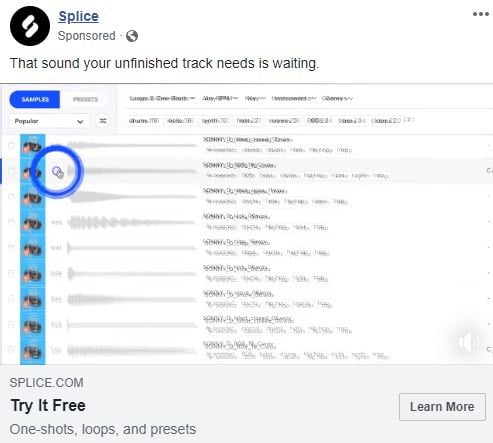
“The sound your unfinished track needs is waiting.” brings up the pain point that the customer is experiencing, and proposes that their music products are the solution. It’s a beautiful example of a one liner.
Make the results tangible
It can be tough to directly say what the benefits are of some products and services. Take SEO, for example. It’s not a physical good or something you can hold in your hands.
That’s why you need to be able to write Facebook ad copy that lays out what you’re offering in a tangible sense. Continuing with the example of SEO, you could say that your services would increase rankings, drive organic traffic, and improve authority.
These are tangible things. They can be tracked and seen by the customer. Here’s an ad I saw recently that uses this strategy.
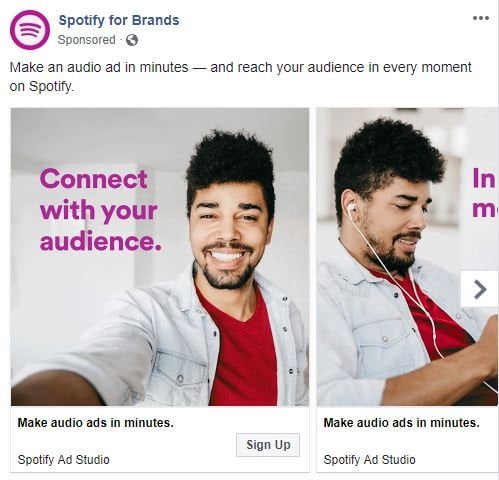
“Make an audio ad in minutes” completely sums up their product, and “reach your audience in every moment on Spotify” makes the result tangible.
Marketers that specifically offer services need to put time into ensuring that customers will clearly understand what they’re receiving like the above example.
Exclusivity
Everybody wants to be apart of a clubhouse.
This is why luxury brands do so well. People are willing to pay a premium to have an item that is rare or exclusive.
Learn from brands like BMW and Louis Vuitton. Consider how you can position your brand or product as being one-of-a-kind.
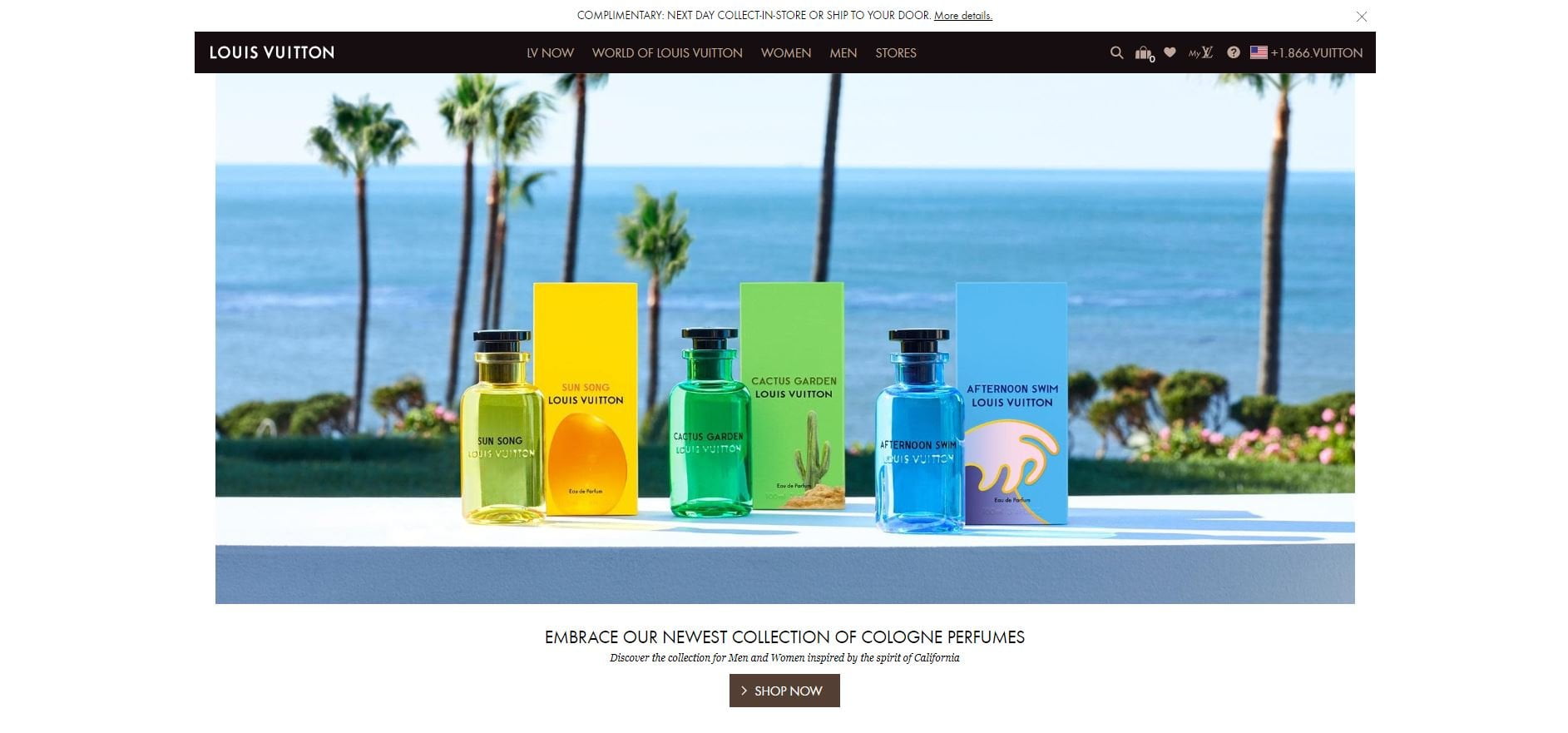
You could use copy such as the following:
- “Only you will know this marketing secret”
- “Premium and rare Italian leather”
- “Hand crafted and hand painted”
Use the power of storytelling
Stories capture the attention and emotions of customers.
In fact, Pamela B. Rutledge, who is the Director of the Media Psychology Research Center and holds a Ph.D and M.B.A believes stories are the most authentic way to connect with others.
In an article she wrote for Psychology Today, Pamela touches on how stories are a very primal form of communication. They have been used in ancient traditions, folklore, myths, religion, and other areas of life.
Pamela also states that the two big components of good stories include collaboration and connection. This means that they should have purpose, emotion, and establish a common ground with others.
Stories also engage the right side of our brain, which is responsible for imagination, empathy, and similar emotions. When a customer begins reading a story, the right side is activated and allows them to be swept into your world.
You can use this information in one of three ways when writing Facebook ads:
- Tell your own story: Have you faced a hardship or have something to share about your product or business that customers can connect with?
- Use customer testimonials: 95% of customers read reviews before making a purchase, which is why including stories from previous customers can drastically improve ad performance. Even a single quote is enough to draw clicks.
- Create a fictional story: You have to abide by FTC rules, so don’t make up a story about how a customer made $1 million from buying your course. However, it’s fine to create a fun fictional story to give more background to a product or service.
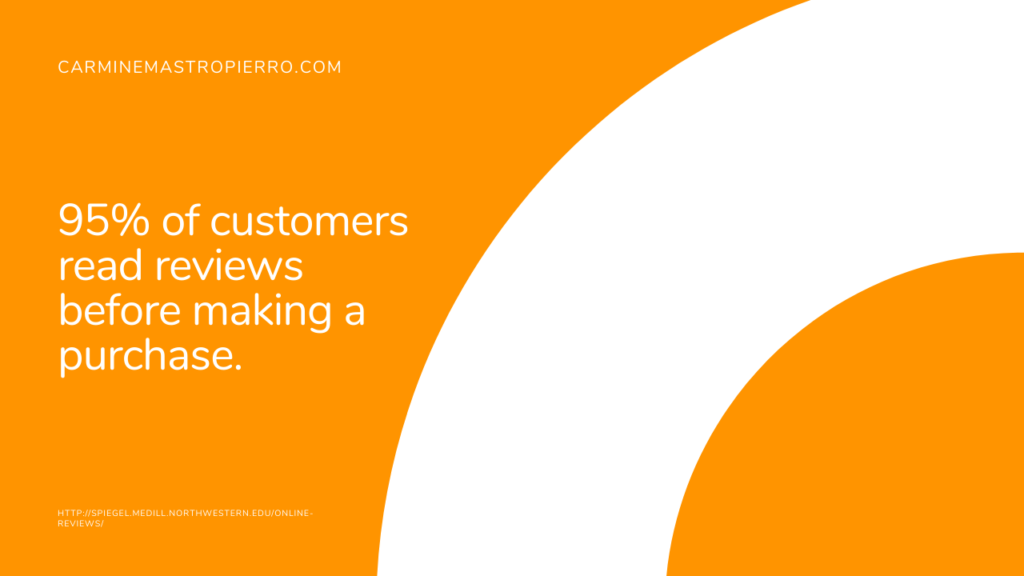
Look how the AI company B12 uses a testimonial in one of their Facebook ads along with the tagline “Trusted by 20,000 Businesses.”

Anticipate questions and objections
Understanding your customer’s inside and out is a critical step for any form of marketing.
If you’ve set up Facebook ads, you should already have a deep understanding of who you’re targeting, their beliefs, experiences, desire, and more.
Getting into the customer’s head like this allows you to predict what questions or objections they have about your product, and answer them ahead of time.
Let’s say that you’re selling men’s cologne. Some questions customers may have could be:
- What activities is this cologne suitable for?
- How long does one spray last?
- How many times should I apply it?
- Where should I spray it?
You could then write Facebook ad copy saying things like:
- “One spray will leave you smelling incredible all day, and allows your bottle to last years.”
- “The best cologne for nightlife and evening activities.”
- “Perfect for days at the office or casual environments.”
I recommend using social media, forums, and online reviews to discover what your customers want and don’t want in a product. You can then answer these questions or solve objections as their thinking them.
Ensure images align with copy
Images and good sales copy go hand-in-hand. They empower one another.
Visuals also help audiences connect the product or service you’re advertising to what they expect the outcome is.
An example of this would be Shopify’s ad targeting freelancers.

This ad is telling freelancers to join Shopify’s partner program, and they use the image of a happy gentleman to accompany it.
What do you think this signals to our brain?
That we will be happier if we join their program and make money.
If they used an image of a sad looking person, do you think it would have very good results?
Probably not.
Use images that not only relate to the sales copy, but help customers picture themselves using it. This is especially important for visual based products like clothing or makeup.
Always use a call to action
A call to action is a statement that instructs users to take the next step in a situation.
“Buy now” or “Sign up today” are simple and common examples of CTAs we see all of the time.
Calls to action are crucial for any type of ad or marketing material. Without one, users may not continue down the sales funnel, and you’ll be leaving a lot of money on the table.
Look at Soundcloud. Advertising their Premier monetization program, they include a call to action that says “Try Soundcloud Pro” with a “Sign up” button next to it.
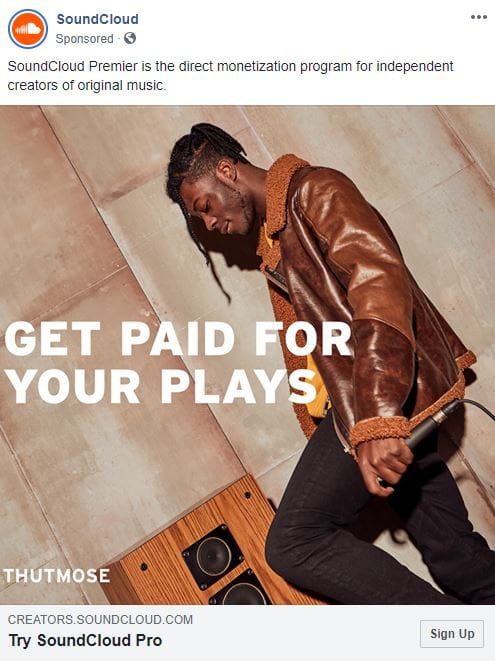
CTAs don’t have to be clever or complex, either. It is one of the most basic and effective copywriting techniques you can begin applying to see better Facebook ad performance today.
Keep it short and sweet
The best sales copy is often short and straight to the point.
While landing page and some material does require thousand of words, especially complicated products, you don’t have much room on Facebook.
This means that you need to clearly summarize your product and its benefits quickly.
Wix schools us on how to do this properly.
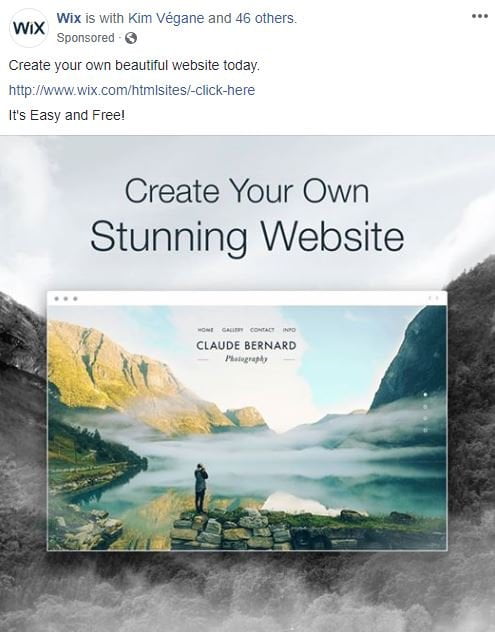
They summarize what they offer in a short sentence, include a call to action, and mention the value propositions of it being easy to use and free.
You can’t beat that 🙂
I’d also like to note that the average human’s attention span has decreased by nearly a quarter in the last 15 years.

This means it’s more important than ever to capture attention quickly, and describe what your business offers even faster!
State exact numbers
People want information. Vague statements and ads aren’t going to get you anywhere because of this.
Providing clarity, depth, and meaning through numbers is crucial when writing ad copy.
Look at this coaching business as an example.
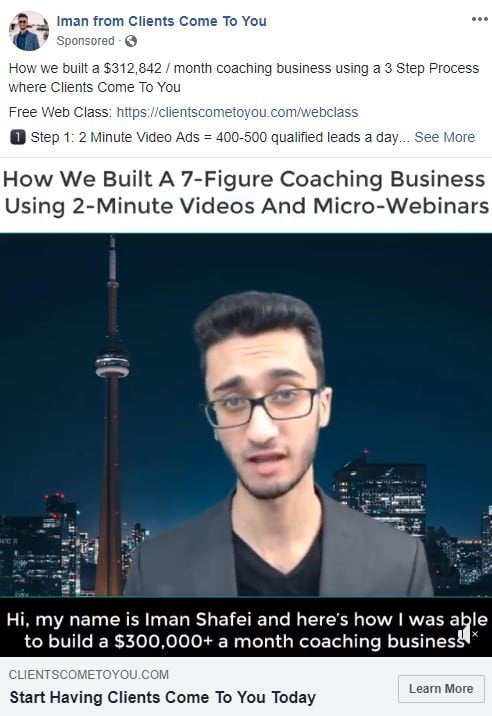
Their ad states exactly how much money they generated using their system, how many steps it takes to get clients, and what every step pertains.
If they would’ve made this ad saying “How we built a coaching business” users would’ve kept on scrolling.
But by stating specific numbers, especially alluring ones, I guarantee that they entice more people to watch their video.
What kind of numbers can you integrate into your own copy? Do you have revenue numbers, customer data, or other information that users would care about hearing?
Adjust copy to different audiences
Do you run several different ads, creatives, and campaigns targeting different audiences?
Segmenting groups of customers is one of the smartest things you can do in marketing, as you can create ads that appeal to every niche in the broad range of people you sell to.
Imagine you ran a fashion company that sold both men’s and women’s clothing. You would want to create unique copy that appeals to these individual groups.
Like they say, you can’t please everyone.
The same goes for copy.
If you try to write ads that resonate with everybody, you’re going to see poor results.
Every small demographic has its own feelings, experiences, and needs, so you need to speak to those directly.
The first way around this is by using a Facebook Pixel. This is a piece of code you can add to your website to collect hypertargeted data on users.
You can then target these individuals with Facebook Ads and create lookalike audiences that resemble them.
Visit Facebook’s Event Manager and click the green plus button to begin.
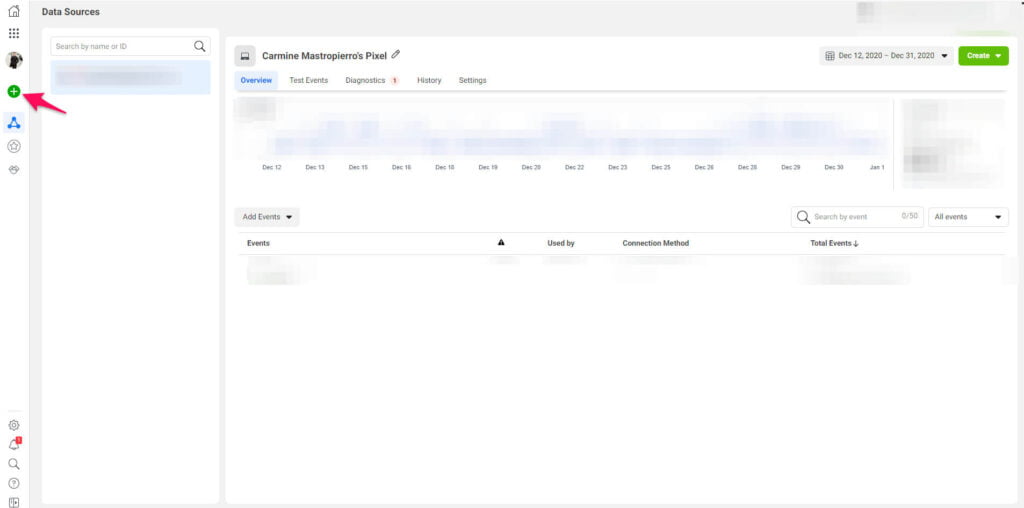
Choose one of the options including web, app, or offline.

In most cases you’ll select “Web,” assign a name, and enter a website URL.
Once the Facebook Pixel is created, you have to add it to your website.
You can do this by manually adding the pixel code to web pages or using a plugin or app.
This data can then be pulled or turned into lookalike audiences when you’re setting the targeting for Facebook Ads.
It’s also important to consider the customer’s stage in the buyer journey.
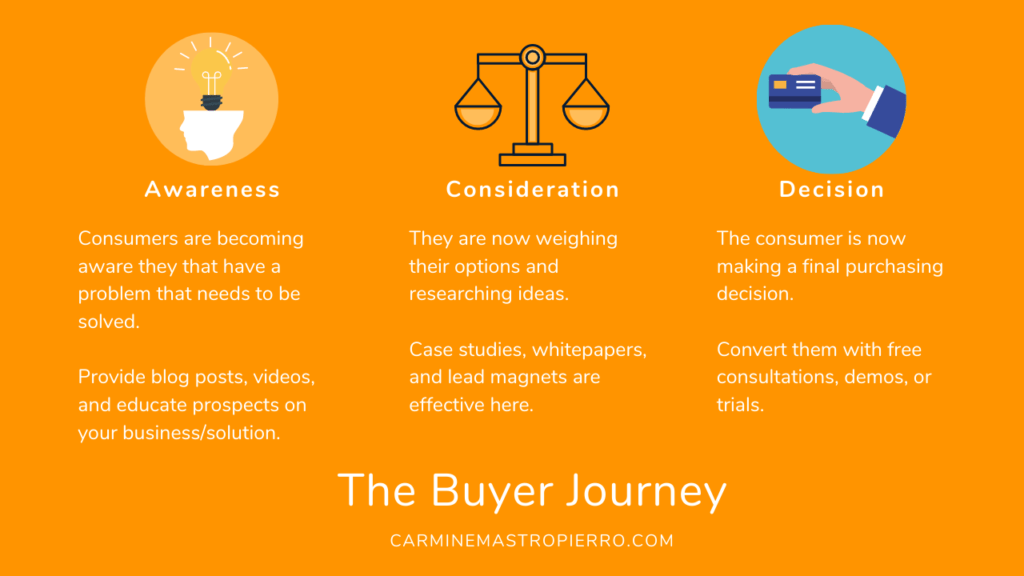
Some people don’t know your brand … others have opted into the funnel already … and existing customers already trust you.
All of these groups require different messages and offers.
I recommend serving education-focused content at the top of the funnel. Think blog posts, YouTube videos, podcasts, etc.
Show you know your stuff and build that initial momentum with people.
Then, get them into your funnel with lead gen ads or driving traffic to landing pages.
People who opt into your email list can be advertised demos, trials, and consultations to close at the bottom of the funnel.
Create credibility and authority to build trust
Customers are naturally skeptical and defensive.
They want to make sure they can trust your brand with their money.
That’s why credibility is so important in advertising.
It helps you overcome objections, build connections, and generate more sales.
One of the first forms of credibility I suggest using is awards and certifications.
If your business has won any kind of awards for it works or growth, leverage them in Facebook Ads.
You can also mention ways you’re certified. For example, some companies are certified by Microsoft, Google, etc. The more precise, the better.
As I mentioned earlier, testimonials are killer too. Nothing converts better than the social proof from a happy customer.
Tie these credibility signals into the product and you’ll have a recipe for making more sales than ever. 🙂
Match Facebook Ads to landing pages
Have you ever clicked an advertisement and saw something unrelated?
Bummer.
It happens a lot, too.
This copywriting mistake can be easily avoided to generate more clicks and conversions.
Firstly, audit the sales copy itself.
Does the messaging on the advertisement match the landing page?
Look for calls to action, features, pricing, and other elements not adding up.
The offer itself needs to be consistent too.
If you tell customers they’re getting your software for $50/month but the pricing page says $60, they’re going to feel misled. 👎
Images and design elements should stay consistent throughout the funnel.
This includes everything from your logo to the colors and typography.
The sub-conscious mind is capable of identifying these small discrepancies, throwing customers off.
Create a sense of mystery
Withholding information can be one of the greatest techniques for generating engagement in an advertisement.
Humans are curious creatures.
You can take advantage of this primal trait by withholding a small amount of information in the ad to drive clicks.
Don’t give it all away. Leave out a key benefit, pricing, a part of the story, etc.
Here’s a Facebook Ad from the company ClickFunnels.

It uses a sense of urgency by telling users to register for the web class “Before it’s TOO late.”
Too late for what? Is registration closing? Is it not being recorded?
The headline also reads “Death Of The Website…”
How did websites die? What can else can I use for my business?
These are some of the questions that might go through your head since ClickFunnels creates that sense of curiosity.
Test short and long ads
You don’t know unless you try.
In many cases, short form Facebook Ads outperform long form ones.
The opposite is true too.
How do you know which one will work better for your business?
By testing.
Begin by writing a short Facebook Ad using one or a combination of the strategies you’ve learned today.
Look at this Black Friday as from Rad as an example.
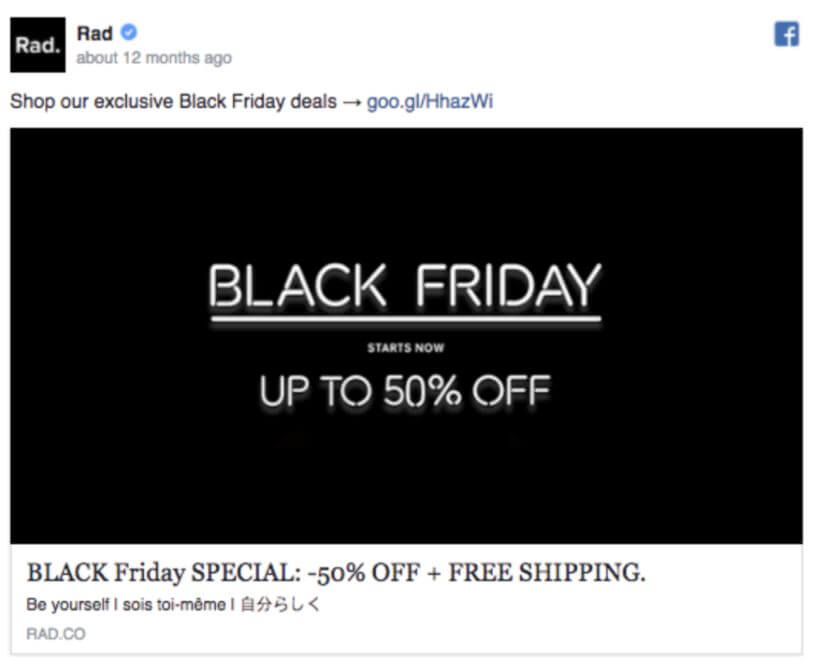
The copy is a short sentence that uses a call to action for shopping its exclusive deals.
Note that the visual aligns with the sales copy and promotes of the benefit of receiving 50% off.
The headline of the ad includes this as well along with stating “Free Shipping.”
Alternatively, Rad could have listed all of its top categories and more benefits for shopping during Black Friday.
Check out this long form Facebook Ad for a hostel to see what I mean.
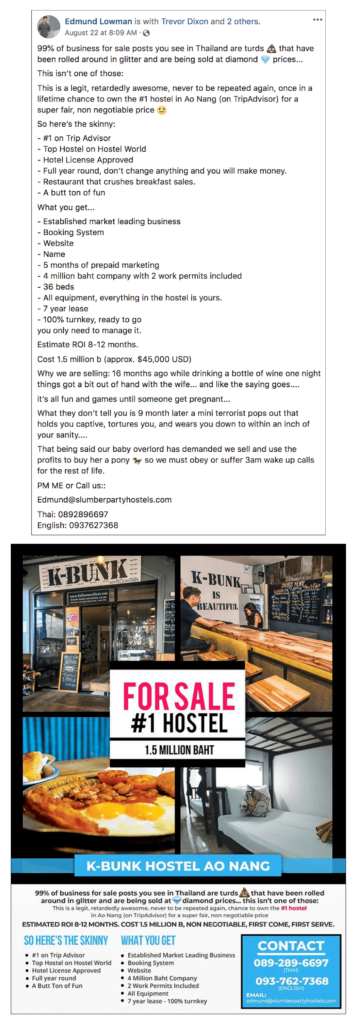
Short form Facebook Ads can pack a quick punch but sometimes you need to elaborate to generate clicks.
Try using a formula like PAS or AIDA across the advertisement.
Lead with a bold statement or interesting statistic to get readers attention.
Talk about the features and benefits of the product you’re selling.
Build credibility and leverage social proof to build trust.
Then, end it with a call to action!
Final thoughts on Facebook Ads copywriting
Facebook ads remain as one of the best investments a busines can make in growing their company.
But just because it’s easy to get started doesn’t mean that good performing ad come easily, too.
You will need to put time and effort into crafting great Facebook ad copywriting that draws users in to take action.
If you need a copywriter for hire, reach out to me for a free consultation.
Here’s a quick summary of the strategies I outlined today.
- Bring up a pain point of the customer, elaborate on it more, and position your product as the solution. This gets customers emotionally involved and interested in your business.
- Speak about the exact results that your product or service will deliver. Avoid being vague and generic.
- Make your product appear exclusive through limited offers, rare materials, or a high price point.
- Tell stories to capture the attention of users. You can use a personal story, a fictional one, or stories from customers.
- Anticipate what questions or objections customers will have, and resolve them in the copy. This helps them move closer to the point of sale, and prevents them from second guessing the purchase.
- Make sure that you use images that align with what you’re advertising, and help the customer imagine what using it would be like.
- Include a call to action in every ad, so customers know exactly what to do next.
- Some of the best advertisements are short and sweet. Try to get the point across as quickly as possible.
- Use exact numbers when describing what you do and offer to avoid ambiguity.
- Write different copy to target the various segments of customers you sell to.















